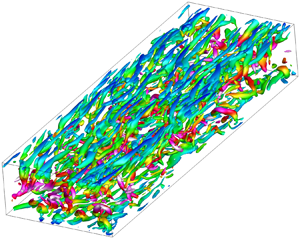Article contents
Artificial-neural-network-based nonlinear algebraic models for large-eddy simulation of compressible wall-bounded turbulence
Published online by Cambridge University Press: 29 March 2023
Abstract

In this paper, we propose artificial-neural-network-based (ANN-based) nonlinear algebraic models for the large-eddy simulation (LES) of compressible wall-bounded turbulence. An innovative modification is applied to the invariants and the tensor bases of the nonlinear algebraic models through using the local grid widths along each direction to normalise the corresponding gradients of the flow variables. Furthermore, the dimensionless model coefficients are determined by the ANN method. The modified ANN-based nonlinear algebraic model (MANA model) has much higher correlation coefficients and much lower relative errors than the dynamic Smagorinsky model (DSM), Vreman model and wall-adapting local eddy-viscosity model in the a priori test. The significantly more accurate estimations of the mean subgrid-scale (SGS) fluxes of the kinetic energy and temperature variance are also obtained by the MANA models in the a priori test. Furthermore, in the a posteriori test, the MANA model can give much more accurate predictions of the flow statistics and the mean SGS fluxes of the kinetic energy and the temperature variance than other traditional eddy-viscosity models in compressible turbulent channel flows with untrained Reynolds numbers, Mach numbers and grid resolutions. The MANA model has a better performance in predicting the flow statistics in supersonic turbulent boundary layer. The MANA model can well predict both direct and inverse transfer of the kinetic energy and temperature variance, which overcomes the inherent shortcoming that the traditional eddy-viscosity models cannot predict the inverse energy transfer. Moreover, the MANA model is computationally more efficient than the DSM.
JFM classification
- Type
- JFM Papers
- Information
- Copyright
- © The Author(s), 2023. Published by Cambridge University Press
References
- 7
- Cited by





